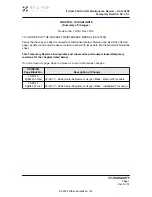
Copyright of RotorSport UK Ltd
Document number RSUK0288
Page 19 of 55
General aircraft testing and requirements post maintenance.
1. Aircraft operation. Any engine service will require the operation of the engine, as
will any maintenance action requiring adjustment of an engine control or
subsystem, or affected system such as removal of the instrument panel. Safely
operating an aircraft, even for a ground run, requires training, and should only be
undertaken with a pilot or suitably experienced person in the pilot seat. Operation
must never be undertaken in a confined space, and always in the open with the
propeller wash pointing away from any buildings or anything of value.
Ensure there are no loose materials in the vicinity that could be sucked into the
propeller, leading to expensive damage.
Ensure the aircraft is chocked to prevent a runaway.
Ensure there are no persons (especially children) or animals in the vicinity of the
aircraft. Any persons required to be present (eg support staff) MUST be suitably
trained or briefed of the danger they are in.
2. This aircraft is equipped with a pitot and static port system. For safe aircraft
operation it is very important that these systems are correctly fitted and checked if
disturbed. Any maintenance operation which removes the instrument panel or
instrument connected to this system must be properly verified for function prior to
flight, as per Pitot System Integrity Test under Standard system checks.
3. Any maintenance action which requires a flight test (eg fitment of an alternative
design of propeller) will result in the requirement for a Permit Flight Release
Certificate (PFRC) to be issued. This is a simple document, and is not included
within the logbooks. It must be retained with the aircraft records.
Aircraft access for maintenance and inspection
The aircraft is fully enclosed; which means access to the ‘workings’ is restricted unless
access panels are removed.
There are several areas of access.
Cabin area.
1. The general cabin area is accessed via the doors on either side of the aircraft. If
required the doors can be removed (see POH).
2. Access to the stick bases is achieved by pulling the gaitor from the base of the stick
(held in place by Velcro). Refitment is by reattaching the gaitor to the Velcro all
around the gaitor.
3. Access to the control sticks is by removing the access hatches (see those sections)
retained by M4 screws. Replacement is by reattaching. There is no loctite required.
4. Access to Circuit breakers is directly on the instrument panel. No tools are required,
and the fuse circuit is shown on the CB.
5. Access to the rear of the instrument panel is achieved by removing the M4 screws
retaining the panel to the aircraft on the panel front face. The panel may be easily
fully removed by disconnecting the harness plugs and hoses, but after re
installation a full functional check of all gauges MUST be completed.
Engine bay.
a) Access to the oil dipstick is via the cover on the right side of the engine cowl, by
undoing the 3 push and turn camlock fasteners. This allows access to the standard
Rotax oil tank and dipstick. Ensure the filler cap is properly secured before refitting
the cover and checking the three fasteners are secured in place.
Page issue 2, dated 11.03.13
Содержание Bishops Castle
Страница 43: ...Copyright of RotorSport UK Ltd Document number RSUK0288 Page 43 of 55 Page issue 4 dated 08 06 15...
Страница 49: ...Copyright of RotorSport UK Ltd Document number RSUK0288 Page 49 of 55 Page issue 3 dated 12 04 13...
Страница 51: ...Copyright of RotorSport UK Ltd Document number RSUK0288 Page 51 of 55 Page issue 3 dated 12 04 13...
Страница 52: ...Copyright of RotorSport UK Ltd Document number RSUK0288 Page 52 of 55 Page issue 3 dated 12 04 13...
Страница 54: ...Copyright of RotorSport UK Ltd Document number RSUK0288 Page 54 of 55 Page issue 3 dated 12 04 13...
















































